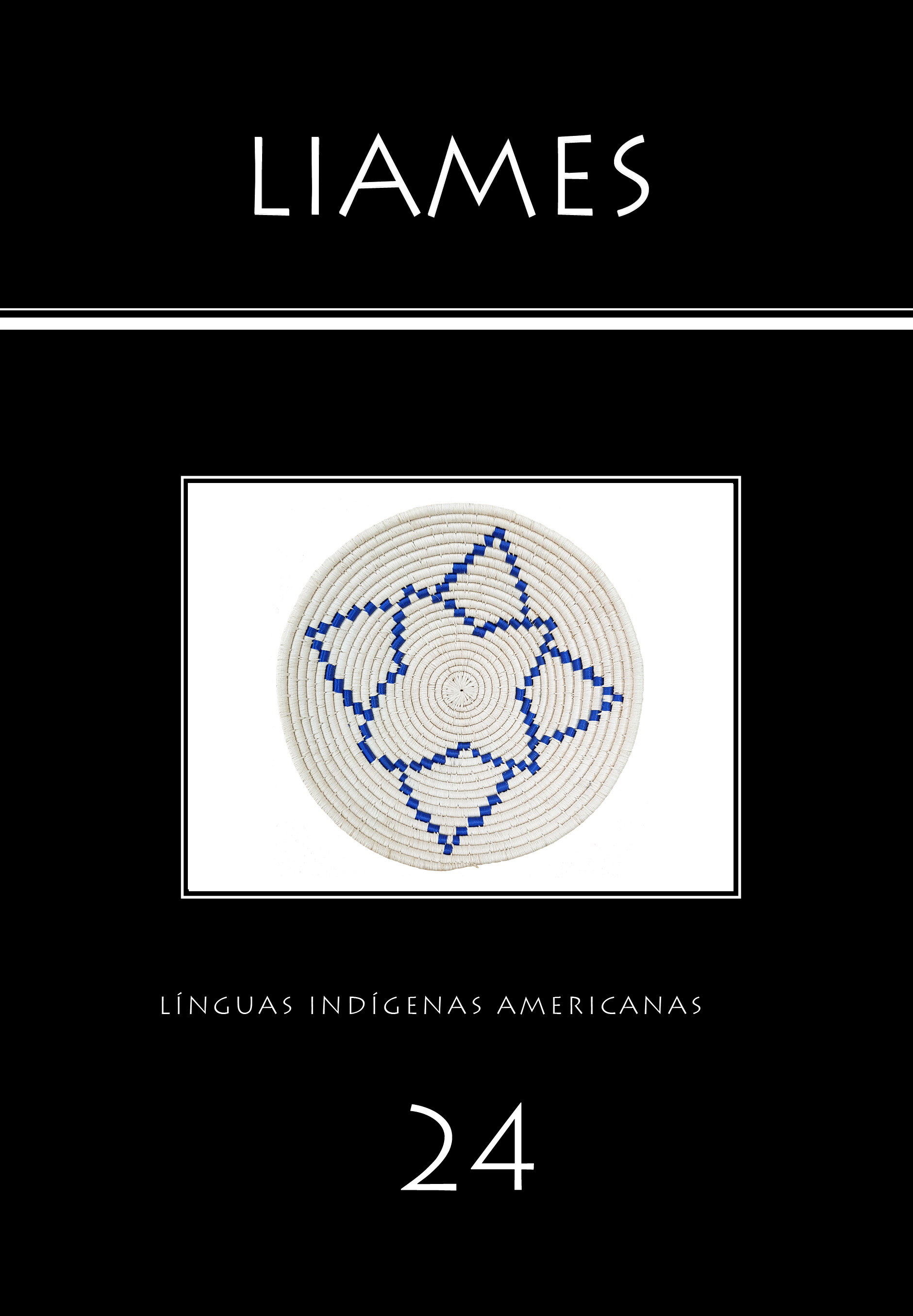Abstract
This paper analyzes the spatial adpositions in three Aruák languages (Baniwa, Tariana and Warekena) spoken in the northwest Amazon, more specifically in the city of São Gabriel da Cachoeira, in the state of Amazonas (Brazil). In this work, the analysis of the semantic representation of space is based on the semantic typology and grammar of space. The semantic representation of motion events is divided into two semantic domains: the static location expression, which refers to an event that does not involve background motion, and the dynamic one that involves motion. These two types are analyzed in this study, based on data collected in previous academic works on the three investigated languages. As a result, we found that static adpositions are predominantly more recurrent, totaling 32 types while dynamic spatial adpositions occur in only 5 cases. In addition, we also verified adpositions that have a more morphosyntactic function, occurring in total in 11 cases, the most common types are the comitative and instrumental and the beneficent. The adpositions analyzed in this study do not regularly exhibit cognates, occurring only in three cases. In short, this paper is just a preliminary investigation of the analysis of space grammar in three Arawak languages, with the aim of being a first step towards a more comprehensive study on this topic in the languages of the Arawak family.
References
Aikhenvald, Alexandra Y. (1998). Warekena. In Desmond C. Desbyshire; Geoffrey K. Pullum (eds.), Handbook of Amazonian languages, pp. 215-439. Mouton de Gruyter.
Aikhenvald, Alexandra Y. (1999). The Arawak language family. In Dixon, R. M. W; Aikhenvald, Alexandra. Y. (eds.), The Amazonia languages, pp. 65-106. Cambridge University Press.
Aikhenvald, Alexandra Y. (2003). Grammar of Tariana. Cambridge University Press.
Aikhenvald, Alexandra Y. (2018). ‘Me’, ‘us’, and ‘other’ Expressing the self in Arawak languages of South America with a focus on Tariana. In Minyao Huang; Kasia M. Jaszczolt (eds.), Expressing the Self, pp.13-38. Oxford University. https://doi.org/10.1093/oso/9780198786658.003.0002
Aikhenvald, Alexandra Y.; Dixon, R. M. W. (eds.) (2017). The Cambridge handbook of linguistic typology. Cambridge University Press.
Brewer, Brill; Pears, Julian (1993). General introduction: Frames of reference. In Noamy Eilan; Rosaleen McCarthy; Brill Brewer (eds.), Spatial representation: Problems in philosophy and psychology, pp.25-30. Oxford; Cambridge Maas.: Blackwell.
Blühdorn, Hardarik (1999). A codificação de informação espacial: no Alemão e no Português do Brasil: Adposições e advérbios como meios para especificar relações espaciais (Tese de doutorado em linguística). Universidade de São Paulo.
https://doi.org/10.11606/T.8.1999.tde-22092022-112915
Carvalho, Fernando O. de. (2009). On the genetic kinship of the languages Tikúna and Yurí. Revista Brasileira de Linguística Antropológica 1(2): 247–268. https://doi.org/10.26512/rbla.v1i2.12369
Chacon, Thiago C.; Cayón, Luis A. (2013). Considerações sobre a exogamia linguística no Noroeste Amazônico. Revista de Letras 6(1/2): 6-20. Disponível em https://portalrevistas.ucb.br/index.php/RL/article/view/5051
Dryer, Matthew S. (2013). Order of adposition and noun phrase. In Matthew S. Dryer; Martin Haspelmath (eds.), WALS Online (v2020.3) [Data set]. Zenodo. https://doi.org/10.5281/zenodo.7385533 Available online at http://wals.info/chapter/85
Epps, Patience; Salanova, Andrés P. (2012). A linguística Amazônica hoje. Liames-Línguas Indígenas Americanas 12: 7-37.
https://doi.org/10.20396/liames.v0i12.1481
Epps, Patience; Stenzel, Kristine (eds.) (2013). Upper Rio Negro: Cultural and linguistic interaction in Northwestern Amazonia. Rio de Janeiro: Museu do Índio – FUNAI, Museu Nacional.
Epps, Patience; Michael, Lev (2023). Introduction: The languages of Amazonia. In Patience Epps; Lev Michael (eds.), Volume 1 Language Isolates I: Aikanã to Kandozi-Shapra: An International Handbook (pp. xvii-lxii). De Gruyter Mouton. https://doi.org/10.1515/9783110419405-203
Guerrero-Beltran, David F. (2019). The grammar of space in Karijona, a Cariban language from Northwest Amazonia (Master of Arts in Linguistics). Universidade Nacional de Colômbia. Disponível online: https://repositorio.unal.edu.co/handle/unal/75983
Hickmann, Maya; Robert, Stéphane (eds.) (2006). Space in language: Linguistic systems and cognitive categories [Typological Studies in Language 66]. John Benjamins Publishing Company. https://doi.org/10.1075/tsl.66
Levinson, Stephen C. (2004). Space in language and cognition: Exploration in cognitive Diversity [Language, Culture & Cognition Seies 5]. Cambridge University Press. https://doi.org/10.1017/CBO9780511613609
Levinson, Stephen; Wilkins, David P. (2006). Grammars of space: Explorations in cognitive diversity [Language, Culture & Cognition Seies 6]. Cambridge University Press. https://doi.org/10.1017/CBO9780511486753
Mani, Inderjeet; Pustejoysky, James (2012). Interpreting motion: Grounded representation for spatial language [Explorations in Language and Space]. Oxford University Press.
Meira, Márcio (2018). O noroeste amazônico. A persistência do aviamento: colonialismo e história indígena no Noroeste Amazônico [online]. EdUFSCar, pp. 55-88. https://doi.org/10.7476/9786586768435.0005
Miranda, Camille C. (2023). Estudo morfológico em línguas Arawak: uma abordagem tipológica (Tese de doutorado em linguística). Universidade Estadual de Campinas. Disponível online: https://repositorio.unicamp.br/acervo/detalhe/1342902
Nikolin, Andrey (2020). Proto-Macro-Jê: um estudo reconstrutivo (Tese de doutorado em linguística). Universidade de Brasília). Disponível em http://repositorio2.unb.br/jspui/handle/18482/38893
Ospina-Bozzi, Ana María (ed.) (2013). Expresión de nociones especiales en lenguas Amazónicas Publicaciones del Instituto Caro y Cuervo [Serie Coediciones 2]. Universidad Nacional de Colombia.
Ramirez, Henri (2001a). Uma gramática do Baniwa do Içana (sine loco).
Ramirez, Henri (2001b). Línguas Aruák da Amazônia Setentrional. Comparação e descrição. Editora da Universidade do Amazonas.
Rhee, Seongha (2021). Linguistic forms at the border of lexis and grammar: Grammaticalization of adposition across language. Global Contents Publishing.
Rodrigues, Aryon D. (1970). Línguas ameríndias. In Grande Enciclopédia Delta Larouse, pp. 4034-4036. Editora Delta.
Svorou, Soteria (1994). The grammar of space [Typological Studies in Language 25]. John Benjamins Publishing Company. https://doi.org/10.1075/tsl,25
Seifart, Frank; Echeverri Juan Alvaro (2014). Evidence for the identification of Carabayo, the language of an uncontacted people of the Colombian Amazon, as belonging to the Tikuna-Yurí linguistic family. Plos One 9(4): e94814.
https://doi.org/10.1371/journal.pone.0094814
Talmy, Leonard (2000a). Toward a cognitive semantics, volume 1: Concept Structuring Systems. MIT Press. https://doi.org/10.7551/mitpress/6847.001.0001
Talmy, Leornad (2000b). Toward a cognitive semantics. MIT Press. Disponível em https://www.acsu.buffalo.edu/~talmy/talmyweb/TCS.html
Vandeloise, Claude (2006). Are there spatial prepositions? In Maya Hickmann; Robert Stéphane (eds.), Space in languages: linguistics systems and cognitive categories, [Typological Studies in Language 66], pp. 137-154. John Benjamins Publishing Company. https://doi.org/10.1075/tsl.66

This work is licensed under a Creative Commons Attribution-NonCommercial 4.0 International License.
Copyright (c) 2024 Camille Cardoso Miranda, Ana Vilacy Galucio


